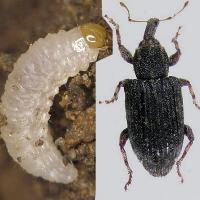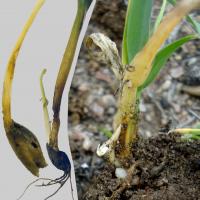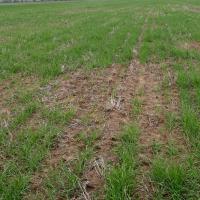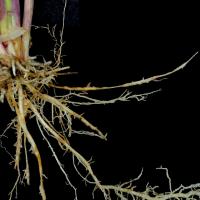Diagnosing Desiantha weevil in cereals
The larvae of Desiantha weevil attack cereal crops especially along the south coast and in late plantings. Larvae feed underground on germinating seeds or stems often killing plants or causing abnormal or stunted growth. Desiantha weevil larvae are white, legless, with orange- brown heads and up to 6 millimetres (mm) long. Larvae remain under the soil and are difficult to locate, although some painstaking digging may reveal larvae close to plants. Adults are mottled grey-black weevils about 5 mm long with the typical weevil snout.
What to look for
- Flightless weevils are about 5 mm long, dark-grey to black and often have a mottled or spotted appearance.
- Adults live on the soil surface but do not damage cereals.
Insect Adult
- White, legless grubs with orange-brown heads and up to 6 mm long.
Insect Larvae
- Patches of dead, weak or dying plants that are mainly found on sandy surfaced soils.
- Symptom severity patterns can vary with practices that may alter weevil egg laying preference, plant density, or plant nutrition.
Paddock
- Larvae chew the swollen seed, or bore into the underground stem of seedlings causing them to wither and die.
- They may bore into tillers at tillering causing them to die.
Plant
What else could it be
| Condition | Similarities | Differences |
|---|---|---|
| Diagnosing waterlogging in cereals | Seedling death | Lack chewing damage to seed, roots, and stem. |
| Diagnosing group C herbicide damage in cereals | Seedling death | Lack chewing damage to seed, roots, and stem. |
| Diagnosing cockchafers | Chew roots and lower stem at emergence | Large C-shaped grubs are present rather small white grubs with a yellow head. |
| Diagnosing African black beetle | Chew roots and lower stem at emergence | Black beetles are present rather small white grubs with a yellow head. |
Where did it come from?

- Native weevils more likely build up to damaging numbers after grassy pastures and when summer rains create a green bridge that enables the weevils to reproduce.
- Desiantha favour sand over gravel and sandy duplex soils.
Management strategies


- Effective control of grass weeds in previous season and of green bridge following summer rain will minimise the risk of crop losses from desiantha.
- The only in-crop treatment is to reseed with insecticide coated seed.
Economic and financial considerations
To assist in assessing the economic risk and financial costs associated with various treatment strategies go to MyEconomicTool
There may be other economic and financial implications that need to be considered when choosing a management option. These may include:
Pre-crop- Is your paddock susceptible to desiantha weevil adult or larval damage?
- Understand the potential yield losses associated with desiantha larvae feeding damage to cereals and adult feeding damage to canola and lupin crops.
- Assess the costs and benefits of taking preventative action.
- Compare the costs, benefits and risks of re-sowing.
- Ignore all previous treatment and sowing costs in assessing current management options.
- Consider using integrated pest management system and include a resistance management strategy into your spray program.
View these economic considerations in more detail.
How can it be monitored?
- Check germinating cereal crops, especially along the south coast and in late plantings, for poor emergence and discoloured and stunted plants.





